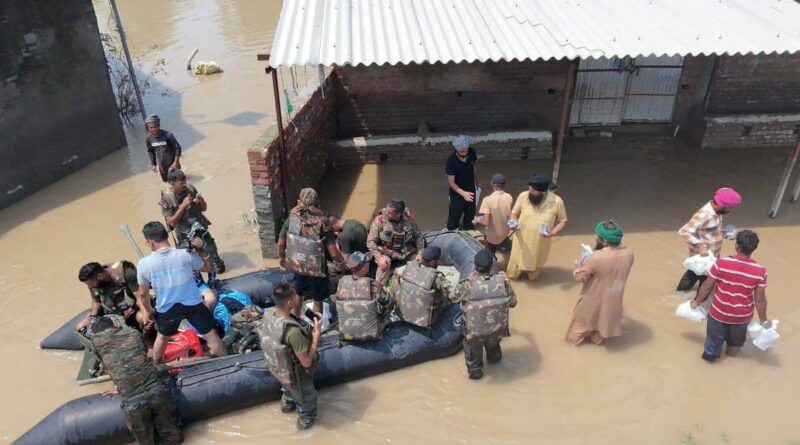Punjab’s Ravi deluge: Why dam management sparked a crisis
Sudden water releases from Punjab’s Ranjit Sagar Dam overwhelmed the Ravi river, flooding northern districts and raising questions about flood preparedness and accountability
NewsArc Bureau
Chandigarh: In late August 2025, Punjab faced its worst floods in nearly four decades, with the Ravi river wreaking havoc across Gurdaspur, Pathankot, Amritsar, and other northern districts. While the Bhakra and Pong dams, managed by the Bhakra Beas Management Board (BBMB), were initially in the spotlight, it was Punjab’s own Ranjit Sagar Dam (RSD) that drove the devastation. This explainer examines the causes of the flooding, the role of dam management, and the broader issues exposed by the crisis.
What Triggered the Ravi’s Fury?
The Ravi river, typically less prone to extreme flooding than the Sutlej or Beas, became the epicentre of Punjab’s 2025 flood crisis. Unlike the BBMB-managed Bhakra and Pong dams, RSD is controlled by Punjab’s irrigation and power departments. In late August, relentless rainfall in the catchment areas of Himachal Pradesh and Jammu & Kashmir filled RSD to its maximum permissible level of 527.91 metres by August 25. The following day, the reservoir hit 528.008 metres, prompting authorities to release 2.15 lakh cusecs of water—nearly matching the inflow of 2.25 lakh cusecs.
This massive release overwhelmed the Ravi, which has a safe carrying capacity of only 60,000 to 1 lakh cusecs. Downstream, the Madhopur barrage recorded flows of 2.22 lakh cusecs, snapping two of its gates under the pressure. The situation worsened when the Ujh river, a Ravi tributary, added 2.06 lakh cusecs, amplifying the flood surge in Gurdaspur and beyond. Even as villages drowned, RSD continued releasing over 1 lakh cusecs on August 29 and 42,000 cusecs on August 31, despite inflows dropping to 22,000 cusecs, prolonging the downstream crisis.
Why Were Such Large Releases Necessary?
Punjab officials cited unprecedented rainfall and high reservoir levels as the primary reasons for the releases. The state received 591.8 mm of rainfall from June 24, 53% above normal, according to the India Meteorological Department (IMD). With RSD already near capacity before the peak inflows, officials said they had “no choice but to release large volumes quickly” to protect the dam’s structural integrity. Water Resources Minister Barinder Goyal noted that all reservoirs, including those managed by BBMB, were brimming, making it nearly impossible to maintain a buffer.
However, critics point to a lack of foresight. Storage levels at RSD were kept high before the heavy rains, leaving little room to absorb the sudden surge. This contrasts with BBMB’s approach, where Bhakra’s reservoir stayed below its maximum, and Pong capped outflows at 85,000 cusecs despite inflows of 2.59 lakh cusecs. BBMB Chairman Manoj Tripathi said discharges were managed cautiously with state consent, rarely exceeding 1 lakh cusecs except for a brief 1.5 lakh cusecs surge.
How Did This Differ from Other Dams?
The contrast between Punjab’s RSD management and BBMB’s handling of Bhakra and Pong is striking. Bhakra’s water level reached 1,678.97 feet, just below its 1,680-foot danger mark, with outflows kept at 73,459 cusecs against inflows of 95,435 cusecs. Pong, despite breaching its 1,390-foot limit, maintained stable embankments. The Sutlej and Beas rivers, fed by these dams, saw minimal flooding compared to the Ravi.
The Ravi’s limited capacity—222 km long and 500 metres wide, compared to the wider and longer Sutlej and Beas—made it particularly vulnerable. A Punjab government report post-2019 floods noted the Ravi’s safe capacity at 60,000 to 1 lakh cusecs, highlighting its weakness as a flood-prone system. The heavy releases from RSD, combined with the Ujh’s contribution, pushed the river far beyond its limits, submerging over 1,400 villages and 3 lakh acres of farmland across Punjab.
Why Is Accountability Under Scrutiny?
Historically, Punjab has blamed BBMB for floods caused by Bhakra or Pong releases. This time, with the Ravi under Punjab’s sole control, the focus has shifted. “Whenever the Sutlej or Beas floods, BBMB gets the blame. This time, the Ravi ravaged the border districts. Shouldn’t accountability begin at home?” asked a senior drainage department expert. Farmers like Harjit Singh from Gurdaspur echoed this, saying, “Our homes and crops were washed away by Ravi waters, but no one is questioning Ranjit Sagar.”
The lack of transparency around RSD’s operations has fuelled debate. Attempts to contact Sher Singh, Chief Engineer (Canals) at Punjab’s Water Resources Department, were unsuccessful, highlighting a perceived silence from state authorities. Critics argue that preemptive releases or better coordination could have mitigated the crisis, pointing to BBMB’s more restrained approach as a model.
What Broader Issues Does This Highlight?
The 2025 floods, which killed at least 48 people and affected 3.9 lakh across 2,050 villages, underscore systemic issues in Punjab’s flood management. Climate change, with its increasingly erratic rainfall patterns, has exacerbated the state’s vulnerability. Poor drainage, encroachments on floodplains, and weak embankments—issues noted in studies since 2013—worsened the impact. Illegal sand mining, blamed for altering river courses, further aggravated the crisis, with Congress MP Dr Amar Singh accusing the state government of inaction.
The floods also highlight the need for better inter-state coordination and early warning systems. Pakistan accused India of “water aggression” by releasing excess water without timely alerts, though experts argue that full reservoirs and heavy monsoons left little choice. The Indus Waters Treaty requires India to warn Pakistan of abnormal flows, but both nations need improved real-time data sharing to manage cross-border impacts.
What’s Next for Punjab?
With damages estimated at 1.75 lakh hectares of crops and significant livestock losses, Punjab faces a long recovery. The state has been declared disaster-hit, with relief efforts involving the Army, NDRF, and BSF. However, the crisis has sparked calls for a review of dam management protocols, stronger embankments, and proactive measures to address climate-driven extreme weather. As Punjab rebuilds, the Ravi floods serve as a sobering lesson in the need for transparency, preparedness, and accountability in managing its rivers.




